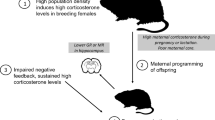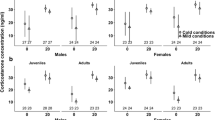Abstract
The allostatic load model describes how individuals maintain homeostasis in challenging environment and posits that costs induced by a chronic perturbation (i.e., allostatic load) are correlated to the secretion of glucocorticoids, such as corticosterone. Habitat perturbations from anthropogenic activities are multiple and functional responses to those are still unclear. Here, we manipulated the habitat quality in 24 semi-natural populations of the common lizard during 1 year. We tested the predictions of the allostatic load model that habitat degradation should increase baseline corticosterone levels, and should induce concomitant physiological changes, such as lipid mobilization and lower immunocompetence, and demographic changes, such as lower body growth, survival and/or reproductive performances. Our results highlight stage-dependent effects of habitat degradation on physiological traits during the breeding season: adult lizards had higher baseline corticosterone levels and yearling lizards had a lower inflammatory response than adults, whereas juveniles had higher circulating lipid levels than yearlings and adults without concomitant change in corticosterone levels. In addition, habitat degradation reduced the performances of adults but not of juveniles: in low habitat quality populations, adult males had a lower survival and females had a smaller fecundity. These results are in accordance with the allostatic load model given that allostatic load was detected only during the season and in life stages of maximal energy expenditure. This underlines the importance to account for individual energy requirements to better understand demographic responses to habitat perturbation.


Similar content being viewed by others
References
Almasi B, Beziers P, Roulin A, Jenni L (2015) Agricultural land use and human presence around breeding sites increase stress-hormone levels and decrease body mass in barn owl nestlings. Oecologia 179:89–101. doi:10.1007/s00442-015-3318-2
Angelier F, Wingfield JC (2013) Importance of the glucocorticoid stress response in a changing world: theory, hypotheses and perspectives. Gen Comp Endocrinol 190:118–128. doi:10.1016/j.ygcen.2013.05.022
Bates D, Maechler M, Bolker B, Walker S (2015) Fitting linear mixed-effects models using lme4. J Stat Softw 67:1–48. doi:10.18637/jss.v067.i01
Bauwens D, Verheyen RF (1985) The Timing of reproduction in the lizard Lacerata-Vivipara—differences between individual females. J Herpetol 19:353–364. doi:10.2307/1564263
Bauwens D, Vandamme R, Verheyen RF (1989) Synchronization of spring molting with the onset of Mating-behavior in male lizards, Lacerta-Vivipara. J Herpetol 23:89–91. doi:10.2307/1564326
Bleu J, Le Galliard JF, Fitze PS et al (2013) Reproductive allocation strategies: a long-term study on proximate factors and temporal adjustments in a viviparous lizard. Oecologia 171:141–151. doi:10.1007/s00442-012-2401-1
Bonier F, Martin PR, Moore IT, Wingfield JC (2009) Do baseline glucocorticoids predict fitness? Trends Ecol Evol 24:634–642. doi:10.1016/j.tree.2009.04.013
Brown GP, Shilton CM, Shine R (2011) Measuring amphibian immunocompetence: validation of the phytohemagglutinin skin-swelling assay in the cane toad, Rhinella marina. Methods Ecol Evol 2:341–348. doi:10.1111/j.2041-210X.2011.00090.x
Chamaille-Jammes S, Massot M, Aragon P, Clobert J (2006) Global warming and positive fitness response in mountain populations of common lizards Lacerta vivipara. Glob Chang Biol 12:392–402. doi:10.1111/j.1365-2486.2005.01088.x
Cote J, Clobert J, Meylan S, Fitze PS (2006) Experimental enhancement of corticosterone levels positively affects subsequent male survival. Horm Behav 49:320–327. doi:10.1016/j.yhbeh.2005.08.004
Cote J, Clobert J, Poloni LM et al (2010) Food deprivation modifies corticosterone-dependent behavioural shifts in the common lizard. Gen Comp Endocrinol 166:142–151. doi:10.1016/j.ygcen.2009.11.008
Dauphin-Villemant C, Xavier F (1987) Nychthemeral variations of plasma corticosteroids in captive Female Lacerta vivipara Jacquin—influence of stress and reproductive state. Gen Comp Endocrinol 67:292–302. doi:10.1016/0016-6480(87)90183-3
De Fraipont M, Clobert J, John H, Alder S (2000) Increased pre-natal maternal corticosterone promotes philopatry of offspring in common lizards Lacerta vivipara. J Anim Ecol 69:404–413. doi:10.1046/j.1365-2656.2000.00405.x
Ellenberg U, Setiawan AN, Cree A et al (2007) Elevated hormonal stress response and reduced reproductive output in Yellow-eyed penguins exposed to unregulated tourism. Gen Comp Endocrinol 152:54–63. doi:10.1016/j.ygcen.2007.02.022
Escribano-Avila G, Pettorelli N, Virgós E et al (2013) Testing Cort-Fitness and Cort-Adaptation hypotheses in a habitat suitability gradient for roe deer. Acta Oecol 53:38–48. doi:10.1016/j.actao.2013.08.003
Fefferman NH, Romero LM (2013) Can physiological stress alter population persistence? A model with conservation implications. Conserv Physiol 1:13. doi:10.1093/conphys/cot012
Folstad I, Karter AJ (1992) Parasites, bright males, and the immunocompetence handicap. Am Nat 139:603–622
Holmgren M, Scheffer M, Ezcurra E et al (2001) El Nino effects on the dynamics of terrestrial ecosystems. Trends Ecol Evol 16:89–94. doi:10.1016/s0169-5347(00)02052-8
Homan RN, Reed JM, Romero LM (2003) Corticosterone concentrations in free-living spotted salamanders (Ambystoma maculatum). Gen Comp Endocrinol 130:165–171. doi:10.1016/s0016-6480(02)00578-6
Janin A, Lena J-P, Joly P (2010) Beyond occurrence: body condition and stress hormone as integrative indicators of habitat availability and fragmentation in the common toad. Biol Conserv 144:1008–1016. doi:10.1016/j.biocon.2010.12.009
Johnson EO, Kamilaris TC, Chrousos GP, Gold PW (1992) Mechanisms of stress—a dynamic overview of hormonal and behavioral homeostasis. Neurosci Biobehav Rev 16:115–130. doi:10.1016/s0149-7634(05)80175-7
Kuznetsov VA, Tchabovsky AV, Kolosova IE, Moshkin MP (2004) Effect of habitat type and population density on the stress level of midday gerbils (Meriones mefidianus pall.) in free-living populations. Biol Bull 31:628–632. doi:10.1023/B:BIBU.0000049736.02912.e2
Landys MM, Ramenofsky M, Wingfield JC (2006) Actions of glucocorticoids at a seasonal baseline as compared to stress-related levels in the regulation of periodic life processes. Gen Comp Endocrinol 148:132–149. doi:10.1016/j.ygcen.2006.02.013
Le Galliard JF, Ferriere R, Clobert J (2005) Juvenile growth and survival under dietary restriction: are males and females equal? Oikos 111:368–376. doi:10.1111/j.0030-1299.2005.14163.x
Le Galliard JF, Marquis O, Massot M (2010) Cohort variation, climate effects and population dynamics in a short-lived lizard. J Anim Ecol 79:1296–1307. doi:10.1111/j.1365-2656.2010.01732.x
Lecomte J, Clobert J (1996) Dispersal and connectivity in populations of the common lizard Lacerta vivipara: an experimental approach. Acta Oecol 17:585–598
Lenth R (2015) Using lsmeans. 1–28
Lessells CM, Boag PT (1987) Unrepeatable repeatabilities: a common mistake. Auk 104:116–121. doi:10.2307/4087240
Lorenzon P, Clobert J, Oppliger A, John-Alder H (1999) Effect of water constraint on growth rate, activity and body temperature of yearling common lizard (Lacerta vivipara). Oecologia 118:423–430. doi:10.1007/s004420050744
Lorenzon P, Clobert J, Massot M (2001) The contribution of phenotypic plasticity to adaptation in Lacerta vivipara. Evolution (N Y) 55:392–404
Marquis O, Massot M, Le Galliard JF (2008) Intergenerational effects of climate generate cohort variation in lizard reproductive performance. Ecology 89:2575–2583. doi:10.1890/07-1211.1
Martin LB, Han P, Lewittes J et al (2006) Phytohemagglutinin-induced skin swelling in birds: histological support for a classic immunoecological technique. Funct Ecol 20:290–299. doi:10.1111/j.1365-2435.01094.x
Massot M, Clobert J, Pilorge T et al (1992) Density dependence in the common lizard : demographic consequences of a density manipulation 73:1742–1756
McEwen BS, Wingfield JC (2003) The concept of allostasis in biology and biomedicine. Horm Behav 43:2–15. doi:10.1016/s0018-506x(02)00024-7
McEwen BS, Wingfield JC (2010) What is in a name? Integrating homeostasis, allostasis and stress. Horm Behav 57:105–111. doi:10.1016/j.yhbeh.2009.09.011
Meylan S, Clobert J (2005) Is corticosterone-mediated phenotype development adaptive? Maternal corticosterone treatment enhances survival in male lizards. Horm Behav 48:44–52. doi:10.1016/j.yhbeh.2004.11.022
Meylan S, Belliure J, Clobert J, de Fraipont M (2002) Stress and body condition as prenatal and postnatal determinants of dispersal in the common lizard (Lacerta vivipara). Horm Behav 42:319–326. doi:10.1006/hbeh.2002.1827
Meylan S, Haussy C, Voituron Y (2010) Physiological actions of corticosterone and its modulation by an immune challenge in reptiles. Gen Comp Endocrinol 169:158–166. doi:10.1016/j.ygcen.2010.08.002
Mugabo M, Marquis O, Perret S, Le Galliard JF (2010) Immediate and delayed life history effects caused by food deprivation early in life in a short-lived lizard. J Evol Biol 23:1886–1898. doi:10.1111/j.1420-9101.2010.02052.x
Mugabo M, Marquis O, Perret S, Le Galliard JF (2011) Direct and socially-mediated effects of food availability late in life on life-history variation in a short-lived lizard. Oecologia 166:949–960. doi:10.1007/s00442-011-1933-0
Mugabo M, Perret S, Legendre S, Le Galliard JF (2013) Density-dependent life history and the dynamics of small populations. J Anim Ecol 82:1227–1239. doi:10.1111/1365-2656.12109
Mugabo M, Perret S, Decenciere B et al (2015) Density-dependent immunity and parasitism risk in experimental populations of lizards naturally infested by ixodid ticks. Ecology 96:450–460. doi:10.1890/14-0524.1
Navarro-Castilla A, Barja I, Olea PP et al (2014) Are degraded habitats from agricultural crops associated with elevated faecal glucocorticoids in a wild population of common vole (Microtus arvalis)? Mamm Biol 79:36–43. doi:10.1016/j.mambio.2013.08.004
Nelson RJ (1994) An introduction to behavioural endocrinology. Sinauer, Sunderland
Peckett AJ, Wright DC, Riddell MC (2011) The effects of glucocorticoids on adipose tissue lipid metabolism. Metabolism 60:1500–1510. doi:10.1016/j.metabol.2011.06.012
Penalver-Alcazar M, Aragon P, Breedveld MC, Fitze PS (2016) Microhabitat selection in the common lizard: implications of biotic interactions, age, sex, local processes, and model transferability among populations. Ecol Evol 6:3594–3607
R Core Team (2014) R: a language and environment for statistical computing. http://cran.r-project.org/
Romero LM, Wikelski M (2002) Severe effects of low-level oil contamination on wildlife predicted by the corticosterone-stress response: preliminary data and a research agenda. Spill Sci Technol Bull 7:309–313. doi:10.1016/s1353-2561(02)00067-1
Romero LM, Wikelski M (2010) Stress physiology as a predictor of survival in Galapagos marine iguanas. Proc Biol Sci 277:3157–3162. doi:10.1098/rspb.2010.0678
Romero LM, Dickens MJ, Cyr NE (2009) The reactive scope model—A new model integrating homeostasis, allostasis, and stress. Horm Behav 55:375–389. doi:10.1016/j.yhbeh.2008.12.009
Sapolsky RM, Romero LM, Munck AU (2000) How do glucocorticoids influence stress responses? Integrating permissive, suppressive, stimulatory, and preparative actions. Endocr Rev 21:55–89. doi:10.1210/er.21.1.55
Shao C, Chen J, Li L, Zhang L (2012) Ecosystem responses to mowing manipulations in an arid Inner Mongolia steppe: an energy perspective. J Arid Environ 82:1–10. doi:10.1016/j.jaridenv.2012.02.019
Sorci G, Clobert J, Belichon S (1996) Phenotypic plasticity of growth and survival in the common lizard Lacerta vivipara. J Anim Ecol 65:781–790. doi:10.2307/5676
Tarjuelo R, Barja I, Morales MB et al (2015) Effects of human activity on physiological and behavioral responses of an endangered steppe bird. Behav Ecol 26:828–838. doi:10.1093/beheco/arv016
Uchida K, Ushimaru A (2014) Biodiversity declines due to abandonment and intensification of agricultural lands: patterns and mechanisms. Ecol Monogr 84:637–658. doi:10.1890/13-2170.1
Vercken E, de Fraipont M, Dufty AM, Clobert J (2007) Mother’s timing and duration of corticosterone exposure modulate offspring size and natal dispersal in the common lizard (Lacerta vivipara). Horm Behav 51:379–386. doi:10.1016/j.yhbeh.2006.12.006
Vinkler M, Bainova H, Albrecht T (2010) Functional analysis of the skin-swelling response to phytohaemagglutinin. Funct Ecol 24:1081–1086. doi:10.1111/j.1365-2435.2010.01711.x
Wikelski M, Cooke SJ (2006) Conservation physiology. Trends Ecol Evol 21:38–46. doi:10.1016/j.tree.2005.10.018
Wikelski M, Wong V, Chevalier B et al (2002) Marine iguanas die from trace oil pollution. Nature 417:607–608. doi:10.1038/417607a
Wingfield JC (2008) Comparative endocrinology, environment and global change. Gen Comp Endocrinol 157:207–216. doi:10.1016/j.ygcen.2008.04.017
Wingfield JC (2013a) The comparative biology of environmental stress: behavioural endocrinology and variation in ability to cope with novel, changing environments. Anim Behav 85:1127–1133. doi:10.1016/j.anbehav.2013.02.018
Wingfield JC (2013b) Ecological processes and the ecology of stress: the impacts of abiotic environmental factors. Funct Ecol 27:37–44. doi:10.1111/1365-2435.12039
Wingfield JC, Kelley JP, Angelier F (2011) What are extreme environmental conditions and how do organisms cope with them? Curr Zool 57:363–374. doi:10.1093/czoolo/57.3.363
Acknowledgements
We are thankful to students and staff at the CEREEP, especially Samuel Perret and Beatriz Decencière, for assistance in the field and laboratory. This study was funded by the CNRS, the Agence Nationale de la Recherche (ANR-13-JSV7-0011-01 to S.M.) and the Région Île-de-France R2DS program (grant 2013-08 to S.M., J.F.L.G. and R.J.). Protocols were done under the agreement with the Regional ethics committee in animal experiment No3 of the Région Île-de-France. The authors declare that they have no conflict of interest.
Author contribution statement
RJ, SM, and JFLG conceived and designed this study, performed statistical analyses and wrote the manuscript. RJ, SM, JFLG, AD, and SA performed the experiment. RJ, AD, and CH provided biochemical analyses.
Author information
Authors and Affiliations
Corresponding author
Additional information
Communicated by Pawel Koteja.
Rights and permissions
About this article
Cite this article
Josserand, R., Dupoué, A., Agostini, S. et al. Habitat degradation increases stress-hormone levels during the breeding season, and decreases survival and reproduction in adult common lizards. Oecologia 184, 75–86 (2017). https://doi.org/10.1007/s00442-017-3841-4
Received:
Accepted:
Published:
Issue Date:
DOI: https://doi.org/10.1007/s00442-017-3841-4




